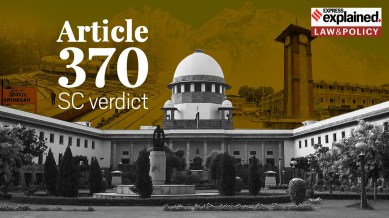SC verdict on abrogation of Article 370 Explained Live: A five-judge Constitution bench, presided by Chief Justice of India DY Chandrachud, had reserved its verdict in the matter on September 5 this year. We explain the verdict and its context.

SC verdict on abrogation of Article 370 Explained Live: The Supreme Court will give its verdict today (December 11) on the Union government’s 2019 move to amend Article 370 of the Constitution. The abrogation ended the special status conferred to the erstwhile state of Jammu and Kashmir.
A five-judge Constitution bench, presided by Chief Justice of India (CJI) DY Chandrachud, had reserved its verdict on as many as 23 petitions in the matter on September 5 this year, after 16 days of hearings. The bench also comprised Justices S K Kaul, Sanjeev Khanna, B R Gavai and Surya Kant.
You have exhausted your
monthly limit of free stories.
Read more stories for free
with an Express account.
Continue reading this and other premium stories with an Express subscription. Use promo code EXPRESS to get 15% off.
This premium article is free for now.
Register to read more free stories and access offers from partners.
Continue reading this and other premium stories with an Express subscription. Use promo code EXPRESS to get 15% off.
This content is exclusive for our subscribers.
Subscribe now to get unlimited access to The Indian Express exclusive and premium stories.
CJI DY Chandrachud read out the verdict. He said that Jammu and Kashmir held no internal sovereignty after accession to India and that there was no prima facie case that the President’s orders were mala file or extraneous exercise of power. While the court says the reorganisation of the erstwhile state into Union Territories in 2019 was a temporary move, it directs Centre for the restoration of statehood. In this live blog, we explain the verdict’s implications and give some context on what has happened so far.
Live Blog
SC verdict on abrogation of Article 370 Explained Live: Scroll down for updates and explanations.
How Article 370 was abrogated: The background
Governor’s Rule was imposed in Jammu and Kashmir on June 19, 2018, after the BJP withdrew support to the coalition government led by People’s Democratic Party (PDP) leader and Chief Minister Mehbooba Mufti. Under Article 92 of the J&K Constitution, six months of Governor’s Rule was mandatory before the state could be put under the President’s Rule.
The Legislative Assembly was dissolved on November 21 and, on December 12, before the end of six months, President’s rule was imposed on J&K. President’s Rule was subsequently approved by both Houses of the Parliament.
On June 12, 2019, President’s Rule was extended for another six months with effect from July 3 of that year.
On August 5, the Centre issued an order amending The Constitution (Application to Jammu and Kashmir) Order, 1954, and superseding it with The Constitution (Application to Jammu and Kashmir) Order, 2019. The new order made “all the provisions of the Constitution” applicable to J&K state. The government also amended Article 367 to add a new Clause (4), making the Constitution of India directly applicable to J&K.
On August 6, the President issued a declaration under Article 370(3) making all its clauses inoperative except the provision that all articles of the Constitution shall apply to J&K.
- The Indian Express website has been rated GREEN for its credibility and trustworthiness by Newsguard, a global service that rates news sources for their journalistic standards.
© The Indian Express Pvt Ltd
First published on: 11-12-2023 at 09:17 IST






